AMD’s Radeon HD 6670 & Radeon HD 6570: Two’s Company, Sub-$100’s A Crowd
by Ryan Smith on April 19, 2011 12:01 AM ESTPower, Temperature, and Noise
Last but not least as always is our look at the power consumption, temperatures, and acoustics of the Radeon HD 6670 and Radeon HD 6570. As we’ve noted previously, these reference designs won’t be sold in the retail market, so while our performance data and power data should be consistent with other cards, temperature and noise data is going to be very dependent on the specific cooler used.
| Radeon HD 6570/6670 Voltage | |||||
| 6570 Idle | 6670 Idle | 6570 Load | 6670 Load | ||
| 0.9v | 0.9v | 1.1v | 1.1v | ||
Both the 6670 and 6570 have the same load voltage of 1.1v. This caught us a bit off guard, since lower clocked parts normally enjoy a lower load voltage. This will be of importance when we’re looking at load power consumption.
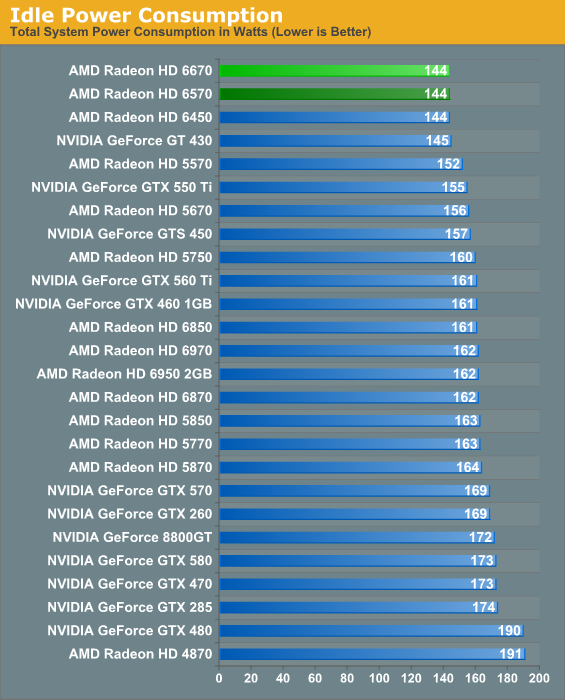
At idle we’re running up against the limits of what a 1200W PSU can do. In reality the 6450 should be consuming at least a few watts less than the 6670 and 6570. The fact that all 3 cards are among the lowest power consuming cards at idle is not a mistake, however.
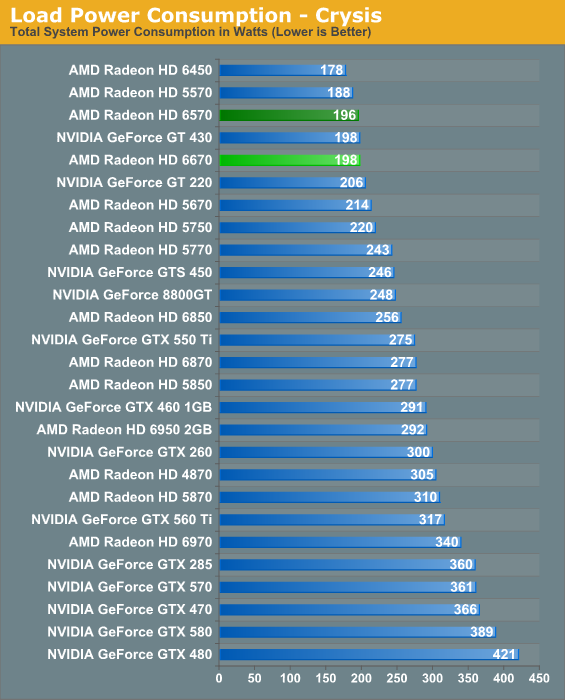
Our Crysis power data surprised us some, and we’re still trying to get to the whys. Both the 6670 and 6570 ended up being sub-200W; this is notable because the 5670 draws 214W in the same test and has a slightly lower TDP than the 6670. In spite of what the specs say, for whatever reason the 6670 is clearly well ahead of the 5670 in both power consumption and performance when it comes to Crysis.
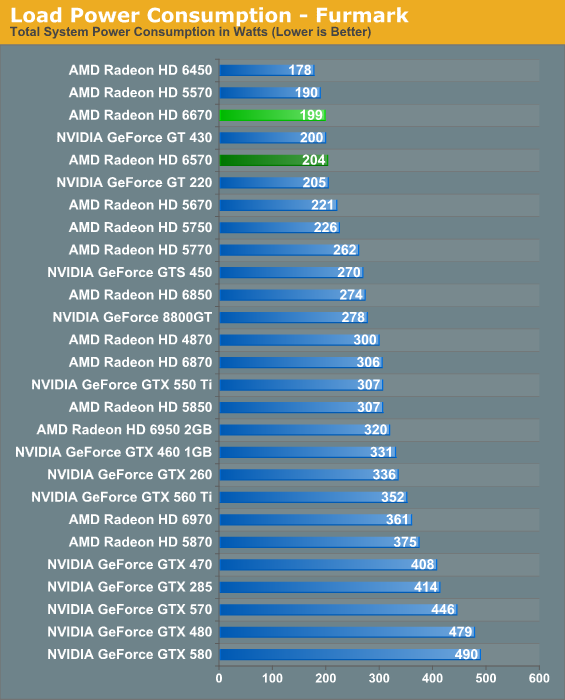
FurMark confirms what we’ve seen with Crysis: the 6670 and 6570 consume less power than the 5670 even with their similar TDPs. In fact the 6570 consumes 5W more than the 6670 even though the latter is the higher clocked and should be the higher consuming card. Given that both cards use fully enabled GPUs at the same load voltage, the difference looks to come down to minor variations in the quality of the individual chips. In this case our 6670 appears to use a better chip than our 6570, hence the difference.
In any case the load power consumption looks very good. The 6670 edges out even the much slower GT 430, while the 6570 similarly edges out the GT 220 DDR3. AMD has done a lot of work on power consumption for Northern Islands and it shows. Meanwhile the fact that the 5750 draws around 25W more is both a curse and a blessing – 25W is quite a lot when Turks cards only draw around 60W in the first place, on the other hand that 25W comes with a lot more performance.
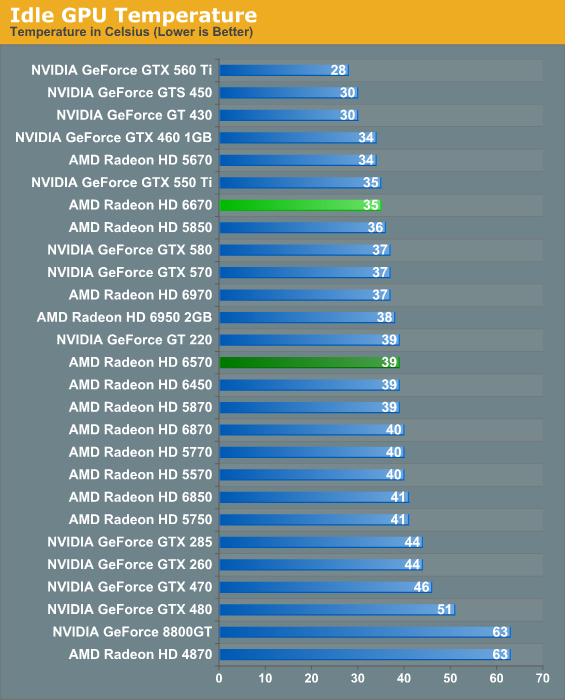
Idle temperatures are roughly where we expect them to be. The 6570 is consistent with the other cards using that model cooler, while the 6670’s new double-wide cooler makes it competitive with all but the coolest of our cards.
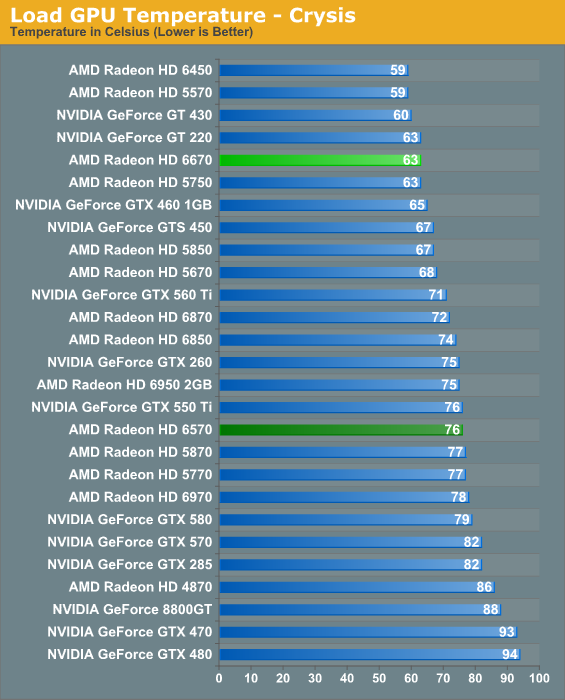
Since we’ve already established that the 6670 and 6570 have similar levels of power consumption, temperatures are almost entirely a product of the cooler in use. The 6670 has a larger cooler that can move more air, and as a result it’s much cooler than the 6570 under Crysis. In fact the 6570 is probably at its limits for what AMD’s single-wide low-profile cooler can do; dissipating the roughly 40W the GPU produces is no small task for such a small cooler.

Coming from Crysis our temperatures rise slightly, as is normally the case. At 69C the 6670 is extremely well cooled, while the 6570 is quite warm at 82C. Though we won’t see either cooler at retail, this should be a good idea of the range we should expect to see. A double-wide cooler should make for a very cool card, while a single-wide cooler delivers reasonable performance but it will definitely be warm.
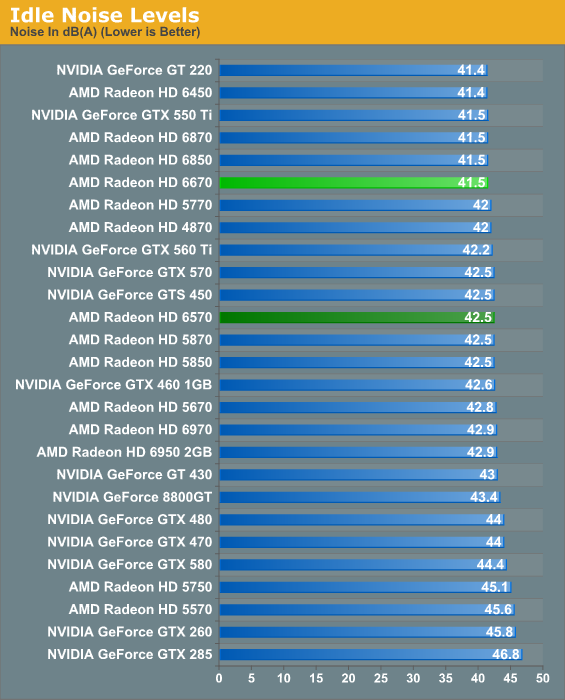
For idle noise, both the 6670 and 6570 are where we’d expect them to be, which is to say almost silent. The 6570 does end up being a bit louder than our noise floor though, which is an interesting outcome given that the 6450 and 5570 are at the noise floor using the same cooler.
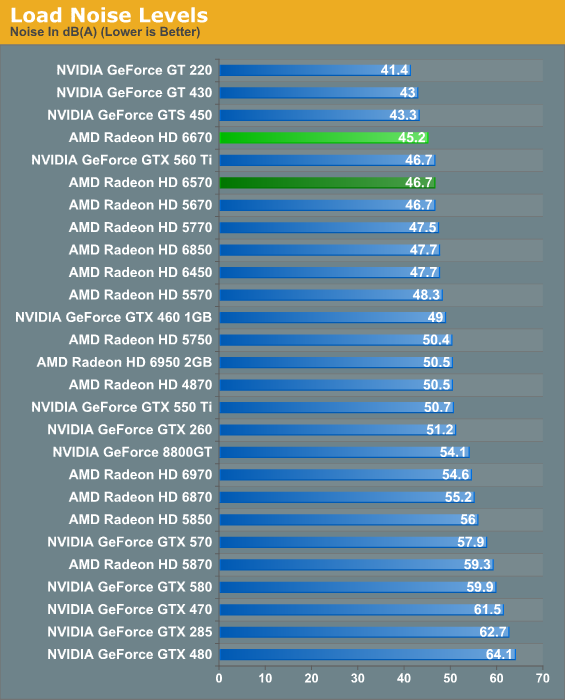
We’re not going to read into our noise results since partner cards will be so different, but if they’re anything like the AMD reference cards then things look pretty good. We’ve had quieter cards, but nothing pushing 60W in a low-profile form factor. If partners go with a full-factor design, then they should be able to meet (or beat) the GTS 450 in noise levels at the cost of some space.
Meanwhile we expect to see passively cooled cards, which should be quite attainable with a full-factor card to hold a larger heatsink.










53 Comments
View All Comments
Ryan Smith - Tuesday, April 19, 2011 - link
Yes, they do. So does the 6450, which is why I suspect 6450 is going to be the best HTPC card for most people.SteelCity1981 - Tuesday, April 19, 2011 - link
I got a 5670 and the 10% increase in performance isn't worth me spening an extra 100+ dollars on a 6670. See what AMD has in stores with the Radeon 7 series.tomoyo - Tuesday, April 19, 2011 - link
Yep, it's not for anyone with a current 5xxx. For me, I may go for this card because I want something low power for htpc + casual gaming, and it should be silence-able as well with the low idle power usage. Also hdmi will be nice with audio when connecting to tvs :)G-Man - Tuesday, April 19, 2011 - link
RyanAre there any plans to do articles where you "revisit" old conclusions and see if they still hold true? Like for Radeon 5670, it wasn't priced well at launch and suffered for it in the review, but after price cuts it's pretty much recommended everywhere in the price segment. It's often hard to understand exactly what Anandtech recommends at the moment, as opposed to at launch.
Thanks!
tomoyo - Tuesday, April 19, 2011 - link
Sounds like one of the only useful things from tomshardware, the video card price guide. I'd say you could always look there if you want to know the best current price/performance cards.789427 - Wednesday, April 20, 2011 - link
Ding, Ding...I enjoy both sites as both provide me with news and different perspectives but Mr Smith, kindly refrain from bad-mouthing your colleagues.
Let me provide you some insight that seems to refute Anandtech and Tomshardware *shared* claims about the latest and best in graphics...
Both sites focussed on noise as being the decision criteria for adopting one top end card over the other. Availability is more pertinent in the case of the high end cards.
To focus on noise as the deal-breaker seemed quite moot when Nvidia doesn't intend shipping 590 cards in volume.
Furthermore, a reference design at this level is simply a speed showcase - I don't for a second think that the majority of cards will be sold based on the reference design but at this level, manufacturers will listen to their client's desires (or to the noise the card actually makes and make some changes;))
In this particular instance, I was amazed at how much your opinions overlapped.
The reason that I've gone to such lengths with this particular example is to highlight what the most useful thing about Anandtech and Toms actually is - a difference of opinion that better highlights the truth often shaded by opinions and preconceptions.
Your comment above should seriously be reconsidered as I believe that as a genre, both sites have actually contributed to each other's success far more than any individual, including yourself, has.
My 2c.
Finally, about the cards... I find both fill a market. new purchasers of 1080 screen non-gamers will be satisfied with the lower offering and people that just want good performance without changing PSUs, heating a room and generally want good bang for the buck. How many people pay MSRP online? So the launch price tends to be higher... Just state the price that you'd recommend it and save us from reading the same old comments over again...
So, the 5750 is going to become an outmode as soon as the 7 series is out. and there are cards to replace it that are cheaper to make and run cooler. Not quite news but good to see in the flesh. Wasn't the real story of the 6 series that AMD finally got crossfire to scale right? ah well...
Soulkeeper - Tuesday, April 19, 2011 - link
I'd like to see the stats tables include the memory bandwidth so I don't have to calculate it myself each time I read one of these.thanks
AstroGuardian - Thursday, April 21, 2011 - link
+1Arnulf - Tuesday, April 19, 2011 - link
This not only goes to show how much hardware has improved over time but it also gives owners of older cards, perhaps with a rattling fan or some other issues, plenty of incentive to upgrade. My X1950Pro gave up on me recently so I went for Vapor-X version of HD5770. New card is virtually silent compared to that old beast.Keep up this practice and consider including comparable models from BOTH manufacturers ! :)
vavutsikarios - Tuesday, April 19, 2011 - link
There are 2 things I want to say, both a bit sideways the topic.First, about the paperlaunched 6450, I dont get it. The card is for sale, retail, at various shops here 2 weeks now. Doesnt look like a paperlaunch from where I stand, and this is not the most central part of the world (i live in greece)
Second, and more important, there is an upcoming game I d like to see in reviews. I am talking about might and magic heroes 6, scheduled to launch on June 23.
There is an interesting twist about it, most probably. I mean, if the game is anything like its predecessors, its going to be much more useful as a CPU than as a GPU benchmark. I mean, you can easily play a turn based strategy while on 15-20 fps. They are enough. But when I run the 6 years old heroes 5, with all the graphics details on high, no problem there, I still have to wait for the AI to complete their turn. The game is CPU limited SIX YEARS after it was released!!